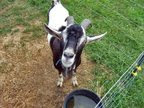Of course, before you go to immerse yourself into goat keeping, it is best to know that the first step in goat care is knowing what is normal for goats. Before one should ever try to begin a career or livelihood out of goat keeping, it is equally important to know that goat -care also means understanding basic physiological and biological norms for goats.
First thing’s first, get an animal rectal thermometer from a local veterinary clinic or supply store. Normal rectal temperature should be in the range of 39 – 40 degrees, for which they should be checked with a thermometer. This can be done also by asking for assistance from a local veterinarian.
Pulse rate is in the range of 70 -80 beats per minute. This determines the goat’s heart rate and at this rate, this is indicative of a good and healthy heart pumping enough blood to circulate throughout the goat’s body.
On the other hand, respiration is in the range of 15 – 30 per minute, this determines the goat’s lung function and how it takes in oxygen. A rapid respiration rate could mean allergic reactions or infection, or a very slow respiration rate could mean either a lack of proper nutrition or health deterioration.
Rumen Movement is 1 – 1.5 per minute and oestrus development occurs within 17 – 23 days. GA goat’s gestation period goes at the range of 143 – 155 days, while puberty is just 2 months for bucks. The averages lifespan of bucks is around 8 to 12 years, while does have an average lifespan of 11 to 12 years and could even go to as long as 20 years, provided it is in good health.
The average growth of goats from birth to maturity is 3 years, for which goats may be able to readily breed and produce offspring.
Goats generally hate getting wet, but drinks large amounts of water to keep themselves cool and refreshed.
Goats are also picky animals, since they hate drinking water that they feel is not clean or muddy nor the drinking vessel not clean or soiled.
Their habitats should be designed enough to protect them from sudden or even continuous drafts or strong wind currents, as well as one that can also protect the animals from rain and the sun.
A three –sided pen or shelter would be appropriate and one that will provide good air ventilation and access to the sun and grazing area.
Have at least two goats in one barn or pen, especially for those who may want to care for goats as a hobby, since goats are considered social animals and would need to have a companion, otherwise they feel lonely after a few weeks and could affect feeding and well-being.
Goats are also easily bothered by flies, especially during warmer months, so it would be good to also protect them from these pests.
Regardless of whether the climate is cold or warm, always make it a point to maintain a clean and sanitary goat pen, it will not just prevent flies, it will also avoid germs or dangerous bacteria from getting into contact with your goats.
Keep goat food away from sources of contamination like rotting grass or a moist container, which are the primary cause for bacteria and deadly microbes to propagate and can cause illnesses to your goats one contaminated food is ingested.
So be on the know and understand that the first step in goat care is knowing what is normal for your goats.







No comments:
Post a Comment